 On this page, you will find books about climate change science and solutions that we or our friends have read and would recommend.
On this page, you will find books about climate change science and solutions that we or our friends have read and would recommend.
Books for Adults
- Clade by James Bradley
- This Changes Everything by Naomi Klein
- Human Transit by Jarrett Walker
- Reinventing Collapse by Dmitry Orlov
- The Hockey Stick & Climate Wars by Michael Mann
- Generation Us by Andrew Weaver
- Climate, Culture, Change By Timothy B. Leduc
- Keeping our cool by Andrew Weaver
- Now or Never by Tim Flannery
- Climate Cover-up by James Hoggan
- The Weather Makers by Tim Flannery
- Heat by George Monbiot
- Storms of My Grandchildren by James Hansen
- The Polar Bear’s Home by Lara Bergen
- The Magic School Bus and the Climate Challenge by Joanna Cole
- Whose Trees Are These? by Erna Michalow
- The Adventures of Captain Polo by Alan Hesse
- All the Feelings Under the Sun: How to Deal with Climate Change by Leslie Davenport
Books for Adults
Clade
Title: Clade
Author: James Bradley
Publisher: Titan, 2017
Page count: 297
Reviewed by: Rebecca Kingdon
Date reviewed: August 15 2018
Clade by James Bradley is part of a new genre known as cli-fi or climate (change) fiction. Often taking on apocalyptic storylines, cli-fi explores the challenges we are beginning to face- and will continue to experience- with a changing climate.
This story is set in Bradley’s home nation, Australia, but the characters’ travels also provide insight into the various changes different nations are projected to experience. For example, the story addresses major floods in Europe, nations submerged by sea level rise, and species extinctions.
As well, Bradley delves beyond the physical climate changes, to explore the socio-economic, health, and political changes that will assuredly accompany natural disasters. Through various characters, he explores major air quality issues, climate refugee crises, economic crashes, plagues, and escalated wars.
Bradley’s characters also provide an upsetting, yet interesting exploration of how disrupting climate change could be for mental health and those with exceptionalities. While dramatized in the novel, climate change brings uncertain weather, a need for rapid evacuations, and many unknown outcomes that disrupt mental health.
Clade is a quick, thought-provoking read that provides a somewhat realistic perspective into the future of our world under climate change, using some projected science. It is a good introduction into the newer genre of cli-fi, and a lighter read for those looking for a creative projection for a climate reality.
As it was not my favourite writing style, I would recommend also checking out these other cli-fi novels that are not currently found in our library include:
- South Pole Station by Ashley Shelby
- Flight Behaviour by Barbara Kingsolver
- Polar City Red by Jim Laughter
This Changes Everything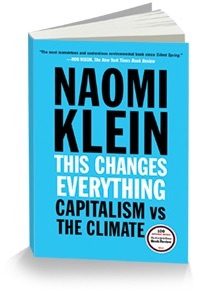
Title: This Changes Everything: Capitalism vs the Climate
Author: Naomi Klein
Publisher: Simon & Schuste, 2014
Page count: 577
Reviewed by: Michael Cann
Date reviewed: November 7, 2016
In “This Changes Everything”, Naomi Klein argues that in order to address climate change we need to first address the inconvenient truth that capitalism is the root cause of our environmental crisis.
This book does an excellent job of explaining how the climate and our current economic model are at odds with each other. The author breaks down the interconnected relationships between consumption, capitalism, and climate through exhaustive research that is documented in 52 pages of notes in the back of the book.
Klein explains that the market can not be trusted to save us because our addiction to profit and growth is digging us into an environmental deficit every day. The key to solving this crisis is to rein in corporate power, rebuild local economies, and reclaim our democracies.
In my experience, most people that have read this book haven’t actually finished it. This book is hard to finish not because of the language or length, but because every chapter highlights just how difficult it will be to address climate change and why the door is closing fast on our ability to do anything about it. For people struggling through the first two parts of the book, I would suggest jumping ahead to the third section “Starting Anyway” to find examples of successes and what to do next.
If you want to know more about the interconnectivity of economics and climate, and are looking for the motivation to do something about the climate crisis, this book is for you.
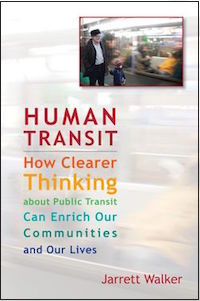 Human Transit
Human Transit
Title: Human Transit: How clearer thinking about public transit can enrich our communities and our lives
Author: Jarrett Walker
Publisher: Island Press, 2011
Page count: 229
Reviewed by: Curt Hull
Date reviewed: March 14, 2015
To reduce greenhouse gas emissions and address climate change, we need to give people an attractive alternative to private automobiles.
This book does an excellent job of telling us how to create a public transit system that satisfies people. In the book’s 16 simple but well-developed chapters, Walker breaks things down for us and lets us know what needs to be done to create a truly effective transit system.
Walker explains the 7 demands that people have for effective transportation. Overall, if transit is to meet those demands, the system needs to be simple (I don’t have to think about it) and dependable (I can rely on it). It also has to exist when you need it (span), and it needs to be coming soon (frequency). To achieve these requirements, policy makers need to decide to focus on ridership rather than coverage.
On this linked page, I have summarized the book’s key ideas. If you value public transit and are interested in understanding what a successful system looks like, read my summary, then buy the book and get all of the details.
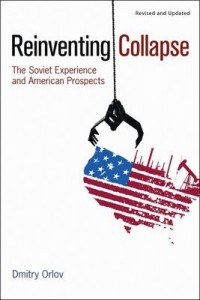 Re-inventing Collapse
Re-inventing Collapse
Title: Reinventing Collapse: The Soviet Example and American Prospects
Author: Dmitry Orlov
Publisher: New Society Publishers, 2008
Page count: 160 (paperback)
Reviewed by: Curt Hull
Date reviewed: March 29, 2014
In the 1990s, the Soviet Union went through a collapse of empire and a dramatic shift in virtually all aspects of society. Today, there are three key challenges that could result in a similar dramatic shift in lifestyle or even collapse in America in the near future: economic uncertainty, energy uncertainty, and climate change.
Dmitry Orlov is an engineer, born in the USSR, who came to the US at 12 years old. He returned to Russia after the collapse to see for himself what was happening to his mother country.
He uses an analysis of what he saw in the Russian experience to determine how the US might fare in response to a collapse due to any of the factors above. With wit and the unflinching critical eye of an outsider, he shows us how woefully unprepared America is for potential shifts ahead.
He starts by showing us the similarities and differences between key social systems in the Soviet and American empires. Through an examination of what happened to those systems in Russia, Orlov projects how each might react to collapse in the US.
For example, most housing in the the Soviet Union was not owned but was rented by the state. When the state collapsed, people stopped paying rent for a while but were not evicted and left homeless. In the US, a great deal of the housing is not owned either – it is mortgaged to banks and financial institutions. If there is a collapse (as occurred in 2008) the first result is eviction and homelessness.
However, he also leaves us with suggestions on how to address and better prepare for what may lie ahead: mitigation, adaptation, and even ways to flourish after the collapse.
This is a thin volume that is packed with valuable insights from a unique perspective.
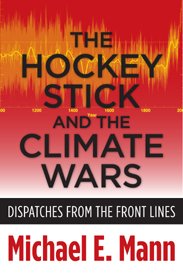 The Hockey Stick & Climate Wars
The Hockey Stick & Climate Wars
Title: The Hockey Stick and the Climate Wars: Dispatches from the Front Lines
Author: Michael E. Mann
Publisher: Columbia University Press, 2012
Page count: 395
Reviewed by: Anika Terton
Date reviewed: Dec 21, 2012
Michael E. Mann is not talking about the anticipated wars over water, natural resources or the social and political breakdown. What he is referring to in his book is how a scientist got inadvertently caught up in a war against climate science. He describes a fascinating story of how the Hockey Stick graph, a clear and visual presentation of scientific data showing historical surface temperatures from proxy data became a bulls-eye target for climate change deniers.
Michael E. Mann is the lead author of the original paper in which the Hockey Stick graph first appeared, and in his book he describes the history of the graph and the ensuing assault from the fossil fuel industry and politicians.
This book will leave you with tremendous empathy for Dr. Mann and what he has gone through: from accusations of being a communist, a fraud, and orchestrating a new world order to death threats, a letter full of suspicious white powder, lobby groups organizing student rallies against Mann on his own campus, daily attacks ads in the campus newspaper, his photo posted as a target on a neo-Nazi website that insisted climate change was a Jewish conspiracy to a state politician from the education committee threatening to cut off funding to the entire university until they fired Michael Mann.
Why all this? Possibly, because Dr. Mann and his colleagues developed an easy-to-understand graph that posed a threat to major corporate energy interests and those who represent their political will. The graph, which achieved prominence in a 2001 UN report on climate change, demonstrates that global temperatures haven risen in conjunction with the increase in industrialization and the use of fossil fuels.
Yet in the end, Mann comes across as hopeful and finishes on a thoughtful note “What I could not live with is knowing that I stood by silently as my fellow human beings, confused and misled by the industry-funded propaganda were unwittingly led down a tragic path that would mortgage future generations.”
This book will leave everyone with a real-world taste of what it means to be a scientist who is persecuted by ignorant people that would prefer policy-making is based on corporate interests rather than scientific data. And in the end one question stayed with me: What will our world look like if the fossil fuel industry wins the climate war?
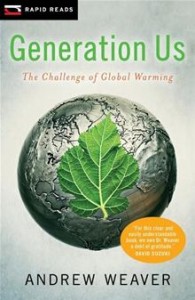 Generation Us
Generation Us
Title: Generation Us: The Challenge of Global Warming
Author: Andrew Weaver
Publisher: Orca Book Publishers 2011
Page count: 128
Reviewed by: Anika Terton
Date reviewed: Jan 4, 2012
“If we want to solve global warming, the Me Generation must evolve into the Us Generation.”
Generation Us is a perfect introduction for someone coming to this topic without any background in climate science.
We all must try to understand the topic of climate change, because it is the most important issue facing all of us today and tomorrow. Global warming has been branded as an environmental problem, but it is really an economic and social problem. We have to leave the time of global warming fear and denial behind us, and start recognizing what it really is: the most self-empowering issue we will ever face.
Climate science is complex and even scientists can find it a difficult task to understand. But let’s face it: if it isn’t complex, it wouldn’t be science. So what do the rest of us do in order to keep up with the science?
Thanks to Dr. Andrew Weaver who has written this little book- just over a 100 pages long. It delivers an easy-to-understand introduction to climate change – every reader will leave this book educated.
Weaver divides the book into three parts:
- He explains the problem and essential basics in order to understand climate change, covering the greenhouse effect, weather vs. climate, why it takes time for the planet to warm, rising sea levels, and the impacts on our planet.
- Part number two and three deal with why you should care about it and what we can do as a society to respond to the problem. Weaver explains the dilemma of the climate crisis by using an analogy of cows. Imagine all farmers grazing their cows on public land shared by all farmers. Each extra cow added to feed off the land would wholly benefit its owner upon sale. But the costs of overgrazing would be borne by all farmers. It’s one farmer’s advantage to add an extra cow, but what if every farmer thinks like him. Cows can’t be added forever, the grass will finally run out. This situation was termed, “The Tragedy of the Commons”, by Garrett Hardin in 1968. Global warming is very much a tragedy of the commons. Countries keep pointing fingers at each other saying, “you go first” and nothing ever gets done. It tells us that a solution to the problem will require people to think about the broader consequences of their individual actions and decisions.
- The last part of the book appeals to our conscience: do we have any responsibility for the well-being of future generations? Weaver uses easy to understand language of important choices we have to make as a society and why we must put a price on carbon. He points out the apathy at elections, especially among young voters and the financial burden we will leave for our children.
If we as individuals and our elected leaders don’t change in behaviour this debt will come with a very high interest rate for future generations.
Don’t avoid the topic of climate change, because it’s large and frightening. If you want a clear understanding but short read – this book is an excellent choice. I also recommend it for high school students.
 Climate, Culture, Change
Climate, Culture, Change
Title: Climate, Culture, Change: Inuit and Western Dialogues with a Warming North
Author: Timothy B. Leduc
Publisher: University of Ottawa Press, 2010
Page count: 267
Reviewed by: Lydia Carpenter
Date reviewed: Dec 6, 2011
Dr. Timothy Leduc is an Assistant Professor at York University whose research focuses on different intellectual views on regional changes to climate research. In his book: Climate, Culture and Change Leduc engages in several different understandings of Inuit ecological and cultural views of today’s northern warming. Dr. Leduc outlines how we might begin to think about the multiple dimension of Inuit Qaujimatuqangit (IQ) (Inuit way of knowing) and brings IQ into dialogue with Western interdisciplinary climate research and culture and Canadian politics
Leduc explores current government policy around climate change and Western culture, politics, economics and religious beliefs. The author suggests that by delaying hard CO2 emission reductions targets Prime Minister Harper’s historic apology to the Inuit regarding the colonial past of the Canadian Government is limited. Without looking and questioning Western culture and economic drivers, including an increasing dependence on fossil fuels, can colonialism be addressed:
“Prime Minister Harper’s colonial apology to Inuit is historically limited by an approach to Climate Change that projects the economic benefits of the tar sands and melting Northwest Passage will outstrip the externalized costs of Northern Warming.”
Climate, Culture and Change is an extremely important book that measures the “cultural scope” of climate change as it relates to political, economic and scientific uncertainties. Drawing on examples from current conservative government environmental policies, Leduc keeps us attuned to our colonial past, present and future.
This is a necessary book that I would recommend to those interested in the cultural dimension of climate change, Inuit Quajimatuqangit (IQ), and the continued impact of colonialism and colonial practice on the dynamics of IQ and Northern Warming.
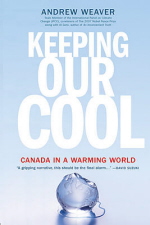 Keeping Our Cool
Keeping Our Cool
Title: Keeping Our Cool: Canada in a Warming World
Author: Andrew Weaver
Publisher: Viking, 2008
Page count: 323
Reviewed by: Lydia Carpenter
Date reviewed: Aug 17, 2011
Dr Andrew Weaver, a professor and researcher at the School of Earth and Ocean Sciences at the University of Victoria, is often referred to as Canada’s top climate scientist. In his book “Keeping Our Cool: Canada in a Warming World” Dr. Weaver begins by providing insight into the climate change ‘debate’ fallacy. He eloquently rejects that there is a debate about climate change and is critical of the media’s need to create an artificial sense of balance between scientists on the one side and policy makers, lobbyists, journalists and commentators on the other.
He is clear, unwavering and pragmatic in his defense of climate change science against the claims of non-scientists. He defends the need for a book that takes a comprehensive look at global warming and climate change by a climate scientist and in so doing he acknowledges that: “… for the average person, the scientific jargon emanating from [the] mouths [of scientists] translates into gobbledygook.” However this book is not gobbledygook, but rather very clear.
Dr Weaver does a fantastic job of presenting climate science in an inclusive and clear way. Using cues from news media, naysayers and general misunderstandings around climate change science he presents each issue individually to explain the complex science of global warming. Using a myriad of scientific references, Weaver explains historic carbon levels and the importance of ice core records, the complexity of climate feedbacks, what triggers an ice age, and the great ocean conveyor belt among other phenomena.
Furthermore, he presents a compelling case for why we must act now and reduce our greenhouse gas emissions. He outlines the ecological and socio-economic impacts of climate change and addresses issues of mitigation and adaptation. He presents a compelling case for why we must act, and is respectful and tactful in doing so.
I recommend this book to those individuals who need clarification and are seeking a better understanding of climate science as it relates to climate change. Weaver’s pragmatic approach makes this a good book for anyone that might have questions about climate science and the misrepresentation of this science by the media.
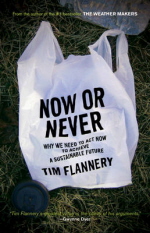 Now or Never
Now or Never
Title: Now or Never: Why We Need to Act Now to Create a Sustainable Future
Author: Tim Flannery
Publisher: HarperCollins Publishers, 2010
Page count: 192
Reviewed by: Steve Rauh
Date reviewed: Jan 7, 2011
Now or Never: Why We Need to Act Now to Create a Sustainable Future is the title of Tim Flannery’s book length call to action essay on climate change. In his book, Tim Flannery is calling for a worldwide shift in values and actions. The climate change polls swing back and forth and the climate change movement is global but disperse. However, the science of climate change leads to the certain conclusion that we need to act now or never.
Flannery turns to climatologist Jim Hansen to state the case: “If humanity wishes to preserve a planet similar to that in which civilization developed and to which life on Earth is adapted, palaeoclimate evidence and ongoing climate change suggest that CO2 will need to be reduced from its current 385 ppm to at most 350 ppm.” In other words, not only stop polluting, but capture almost 1/10th of the pollution that is already in the atmosphere.
Flannery devotes most of his essay to describing ways he believes we can accomplish the task of reducing atmospheric pollution. He addresses the question of stopping the pollution by looking at the “coal conundrum”, and America’s new leadership. He addresses the need to capture pollution by looking at agriculture and forestry.
He does not, however, address the question of political will. I assume that is because he knows the answer to that question lies in the actions that you and I take. Somehow we need to convert anxiety, worry and confusion into action.
I believe that the cliché that where there is a will, there is a way, and the miraculous thing about the human will is that sometimes it appears out of nowhere, when you least expect it. Flannery believes that now is the time for a voice to arise to protect the earth.
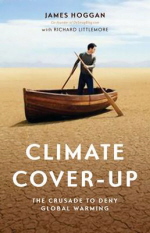 Climate Cover-Up
Climate Cover-Up
Title: Climate Cover-Up: The Crusade to Deny Global Warming
Author: James Hoggan with Richard Littlemore
Publisher: Greystone, 2009
Page count: 235
Reviewed by: Curt Hull
Date reviewed: Dec 29, 2010
Why are there two realities on climate change? Why do scientists and international policy makers work on solutions while editorials, op-ed pages, blogs, Internet commentators, and the US Congress continue to scream “debate” and cry “climate-hoax”.
It is not an accident. There is a denial industry out there. They are wealthy. They are powerful. They are determined. They are clever. They want you to continue to think that greenhouse gas reduction is ruinous and unnecessary and to support politicians who think the same. They have been ruthlessly successful.
Hoggan and Littlemore are founders of DeSmogBlog.com and they come at this subject almost as insiders. James Hoggan owns a successful public relations firm. Richard Littlemore is a newspaperman. They understand marketing and journalism. They are aghast at how their professions are being used by this denial industry to promote a greedy and self-serving agenda that puts coming generations at risk.
In Climate Cover-Up, Hoggan and Littlemore reveal the mechanics behind this industry: how they use the language to shape a message that keeps us debating instead of acting, where the money comes from, (big oil, big coal and the Koch brothers), and what their key tools are (manipulated media, “astroturf” organizations, SLAPP law suits, junk scientists, and biased “think tanks”).
This book may make you angry. Undoubtedly, it will make you aware of the messages you are receiving, who is sending them, and the meaning behind the message.
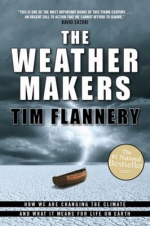 The Weather Makers
The Weather Makers
Title: The Weather Makers: How we are changing the climate and what it means for life on Earth
Author: Tim Flannery
Publisher: Harper Collins, 2005
Page count: 315
Reviewed by: Curt Hull
Date reviewed: Dec 29, 2010
Reading Tim Flannery’s The Weather Makers is a very approachable way to learn about the science of climate change.
The book is in 5 sections.
- The first three sections describe natural and historical climate change, the mechanisms of greenhouse gas induced climate change and what some of the possible futures may be.
- The last two sections deal with current and possible future solutions.
For me, the most powerful message was in the first three sections. Flannery describes how Earth acts as a control system with mechanisms that maintain a stable balance – a steady-state. If the balance is pushed too far, the system will find a new steady-state that may be stable but may be considerably different than the last steady-state. Such historical shifts are “time gateways” that result in the boundaries between epochs.
There are three agents powerful enough to precipitate such precipitous change: shifting of continents, cosmic collisions, and “climate driving forces such as greenhouse gases”. There are positive feedback mechanisms that if we push them too far, could result in large shifts in global temperatures rather than just incremental increases. With this perspective, Flannery shows how huge the consequences of our continued buildup of greenhouse gases may be.
I recommend this book as an excellent compliment to Heat in your climate change library. Whereas Heat concentrates on solution, The Weather Makers gives a thorough understanding of causes and potential impacts.
 Heat
Heat
Title: Heat: How to Stop the Planet from Burning
Author: George Monbiot
Publisher: Doubleday Canada, 2006
Page count: 215
Reviewed by: Curt Hull
Date reviewed: Dec 17, 2010
Okay, so you have accepted that the climate is changing rapidly and that human influenced greenhouse gas emissions are a main cause. You have decided that something needs to be done. But how much will it take? Can we make the changes and still cook our food, light & heat our homes, and move about? Has anyone analyzed the solution to determine if it is possible and what is involved? George Monbiot has done just that and he has put it in this book.
In Heat, Monbiot quantifies what we need to do – reduce our carbon emissions by 90% by 2030. He also explains why – where those numbers come from and why the date is important. He then looks at each of the most important areas that need to be changed to reach that objective (home construction, energy use, energy production, transportation, air travel, consumerism). He quantifies the gains that can be achieved by each solution as he builds a case to say that a solution is plausible and possible if we tackle it earnestly and soon.
I really like the way Monbiot thinks and writes. He has been writing about climate change for many years in The Guardian newspaper from England. His knowledge of the subject and his clear writing style has attracted legions of devoted readers from around the world to his on-line column.
In this book, Monbiot is clear and methodical in both his thinking and his writing, but he is never boring. He puts enough of himself into what he says to make you feel like he is sitting in the room with you and you are having a good chat.
However, this book is written from an English perspective. The analyses don’t always relate to a Manitoban’s reality. But he outlines a methodology that should be repeated for Canadian circumstances.
I recommend this book as an essential piece of your climate change library. Some books are good for explaining the causes and impacts of climate change. Other books give lots of good ideas for solutions. This book takes a hard look at those solution ideas, crunches the numbers, and determines if they could work or not.
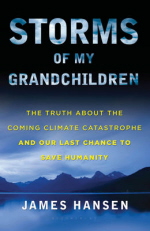 Storms of My Grandchildren
Storms of My Grandchildren
Title: Storms Of My Grandchildren: The Truth About The Coming Climate Catastrophe And Our Last Chance To Save Humanity
Author: James Hansen
Publisher: Bloomsbury, 2009
Page count: 304
Reviewed by: Shawna Plischke Culleton
Review date: Sep 7, 2010
Reading Storms of My Grandchildren by James Hansen, who was head of the NASA Goddard Institute for Space Studies, is rather a lot like learning about climate change from your own wise, and humorous, grandfather. Hansen’s conversational tone animates the history, science and politics of climate change in the United States.
In addition to a wealth of informative climate science (including a few gloomy predictions for our future if we continue to burn fossil fuels at current rates), Hansen provides concrete recommendations for change in this personal plea inspired by his worries for the future of his grandchildren and decades of being ignored by U.S. policy makers. While the original spark for the book was personal, most of Hansen’s recommendations are aimed at national policy makers, not individuals.
I found his assessment of climate change politics and the media to be his most compelling argument. Hansen complains that scientists who argue like lawyers defending a position (the climate change deniers, skeptics, or Contrarians) and not those searching for scientific truths have greater sway with media, culture, and government officials because they are winning rhetoricians – “balance” in the media, when it comes to climate change, does more harm than good. Hansen’s discussion of this pressing topic clarifies why climate change continues to be perceived as such a cloudy issue.
I would recommend this book to any reader with a strong appetite for climate science and U.S. political history. If you like your climate change a little less “science-y”, simply follow the author’s instructions and skip pages 36 – 51! Hansen’s tongue-in-cheek tone make this book an enjoyable read for those who are already committed to learning about climate change.
Books for Kids
By Shawna Plischke Culleton
Hey there parents and teachers! Are you trying to find a great book about climate change for your children or students? Over here at Climate Change Connection we are always on the look out for great resources for young minds. Three books came across my desk recently, so I thought that I would give you the highlights on what each book has to offer, in terms of story, artistic merit and climate science. After all, a book about climate change for children should be entertaining and artful, as well as scientifically accurate. Here they are, reviewed in the order they were read:
The Polar Bears’ Home
 Title: The Polar Bears’ Home: A Story about Global Warming
Title: The Polar Bears’ Home: A Story about Global Warming
Author: Lara Bergen
Illustrator: Vincent Nguyen
Publisher: Little Simon
Page count: 21 pages
Reviewed by: Shawna Plischke Culleton
Review date: Apr 28, 2016
This book presents the story of a young arctic dweller and her father who encounter a pair of polar bear cubs while they are out on a boat ride together one spring on a body of water that is historically frozen for most of the year. They discuss the changes to their climate during the father’s lifetime and the impact these changes are having on the local polar bear population.
The book uses sympathy for the seemingly orphaned bear cubs (of course mom finds them eventually – it’s a kid’s book!) to launch into a very vague description of manmade climate change. The only specifics here are how the loss of ice in the arctic is effecting polar bears. The book also offers a few solutions to climate change that kids can do: Recycle! Turn off the lights! Very basic stuff.
The loss of habitat and declining polar bear population due to ice loss is the only impact of climate change that is discussed in this book. The message is narrow and the climate science is thin, as is the story. The illustrations are well rendered, and were my favourite thing about this book.
I do not recommend this as a children’s book about climate change, but it would be suitable for children who are interested in the plight of polar bears.
The Magic School Bus and the Climate Challenge
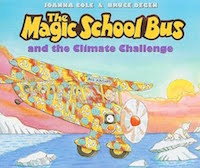 Title: The Magic School Bus and the Climate Challenge
Title: The Magic School Bus and the Climate Challenge
Author: Joanna Cole
Illustrator: Bruce Degen
Publisher: Scholastics
Page count: 40 pages
Reviewed by: Shawna Plischke Culleton
Review date: Apr 28, 2016
This book is part of a great children’s series, and the story and characters will excite kids who are fans of the books or the TV show. There is a ton of great climate science packed onto these pages, and it also provides a thorough review of solutions to the climate challenge.
There is so much fabulous science in these pages! The story even shows children evaluating information with their teacher, “this book is kind of old,” and then doing research to find the most accurate and up-to-date facts about climate change (also referred to as global warming within the book). The book contains a complete presentation of the greenhouse effect, greenhouse gases, and their connection to climate change, and proceeds to review how the industrial revolution has led to manmade climate change.
The second part of the book is dedicated to solutions to the challenge of climate change, beginning with a complete review of renewable energy sources, a pro/con list to evaluate biofuels, and a myriad of other solutions to climate change.
The message is hopeful: “we have the tools we need, we just need to start using them!” I really loved that the book presented solutions for individuals (Recycle! Turn off the lights!), as well as social and cultural changes (mass transit is important!). Children are shown picketing – presumably to the government, with signs that read: “We want more energy choices!” and “We want less greenhouse gasses!”
This book is incredibly informative and empowering. I highly recommend it as a “must read” book about climate change for children.
Whose Trees are These?
 Title: Whose Trees are These?
Title: Whose Trees are These?
Author: Erna Michalow
Illustrator: Erna Michalow
Publisher: Peanut Butter Press
Page count: 32 pages
Reviewed by: Shawna Plischke Culleton
Review date: Apr 28, 2016
This is not a book about climate change, but I liked it anyway. The writing is simple, but poetic, and is paired with very beautiful illustrations of landscapes and nature. The book has no real story, but it does have a message: harmony is important among all the parts of our eco-systems. This is a lovely book with a light environmental message. I can only recommend it for those who are looking for a book about appreciating nature because that is all that it offers.
There is no climate change information contained is this book.




